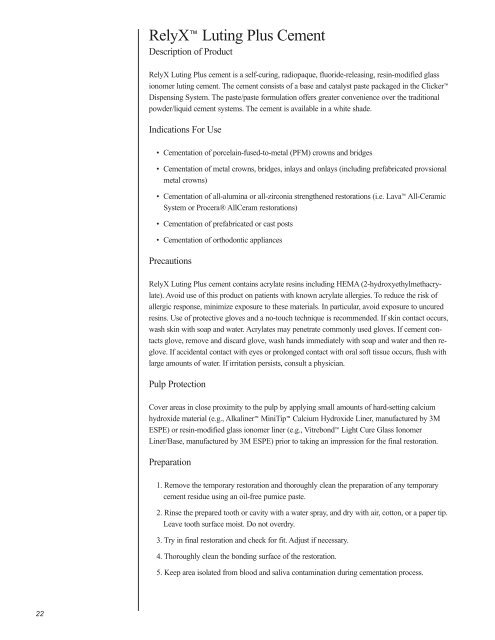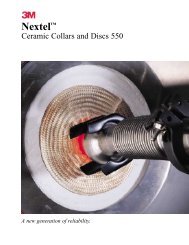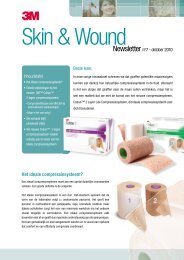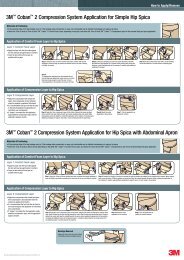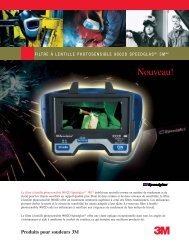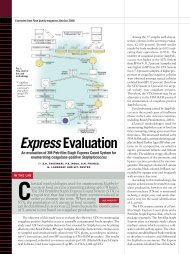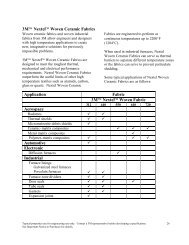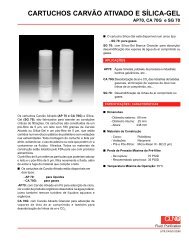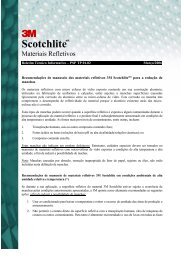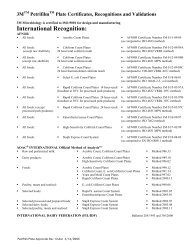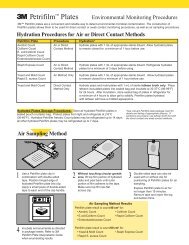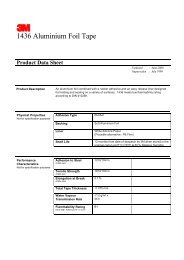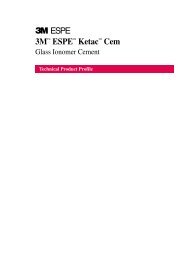RelyX™ Luting and RelyX™ Luting Plus Cement - 3M
RelyX™ Luting and RelyX™ Luting Plus Cement - 3M
RelyX™ Luting and RelyX™ Luting Plus Cement - 3M
You also want an ePaper? Increase the reach of your titles
YUMPU automatically turns print PDFs into web optimized ePapers that Google loves.
22<br />
RelyX <strong>Luting</strong> <strong>Plus</strong> <strong>Cement</strong><br />
Description of Product<br />
RelyX <strong>Luting</strong> <strong>Plus</strong> cement is a self-curing, radiopaque, fluoride-releasing, resin-modified glass<br />
ionomer luting cement. The cement consists of a base <strong>and</strong> catalyst paste packaged in the Clicker <br />
Dispensing System. The paste/paste formulation offers greater convenience over the traditional<br />
powder/liquid cement systems. The cement is available in a white shade.<br />
Indications For Use<br />
• <strong>Cement</strong>ation of porcelain-fused-to-metal (PFM) crowns <strong>and</strong> bridges<br />
• <strong>Cement</strong>ation of metal crowns, bridges, inlays <strong>and</strong> onlays (including prefabricated provsional<br />
metal crowns)<br />
• <strong>Cement</strong>ation of all-alumina or all-zirconia strengthened restorations (i.e. Lava All-Ceramic<br />
System or Procera® AllCeram restorations)<br />
• <strong>Cement</strong>ation of prefabricated or cast posts<br />
• <strong>Cement</strong>ation of orthodontic appliances<br />
Precautions<br />
RelyX <strong>Luting</strong> <strong>Plus</strong> cement contains acrylate resins including HEMA (2-hydroxyethylmethacrylate).<br />
Avoid use of this product on patients with known acrylate allergies. To reduce the risk of<br />
allergic response, minimize exposure to these materials. In particular, avoid exposure to uncured<br />
resins. Use of protective gloves <strong>and</strong> a no-touch technique is recommended. If skin contact occurs,<br />
wash skin with soap <strong>and</strong> water. Acrylates may penetrate commonly used gloves. If cement contacts<br />
glove, remove <strong>and</strong> discard glove, wash h<strong>and</strong>s immediately with soap <strong>and</strong> water <strong>and</strong> then reglove.<br />
If accidental contact with eyes or prolonged contact with oral soft tissue occurs, flush with<br />
large amounts of water. If irritation persists, consult a physician.<br />
Pulp Protection<br />
Cover areas in close proximity to the pulp by applying small amounts of hard-setting calcium<br />
hydroxide material (e.g., Alkaliner MiniTip Calcium Hydroxide Liner, manufactured by <strong>3M</strong><br />
ESPE) or resin-modified glass ionomer liner (e.g., Vitrebond Light Cure Glass Ionomer<br />
Liner/Base, manufactured by <strong>3M</strong> ESPE) prior to taking an impression for the final restoration.<br />
Preparation<br />
1. Remove the temporary restoration <strong>and</strong> thoroughly clean the preparation of any temporary<br />
cement residue using an oil-free pumice paste.<br />
2. Rinse the prepared tooth or cavity with a water spray, <strong>and</strong> dry with air, cotton, or a paper tip.<br />
Leave tooth surface moist. Do not overdry.<br />
3. Try in final restoration <strong>and</strong> check for fit. Adjust if necessary.<br />
4. Thoroughly clean the bonding surface of the restoration.<br />
5. Keep area isolated from blood <strong>and</strong> saliva contamination during cementation process.


